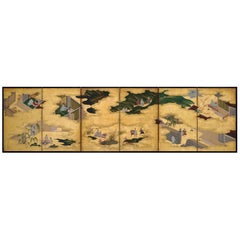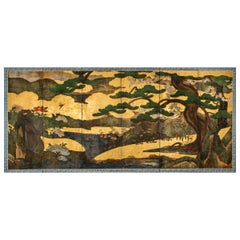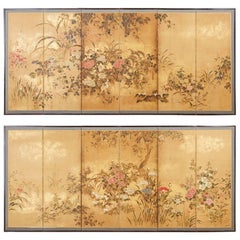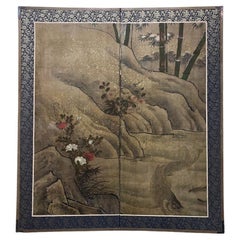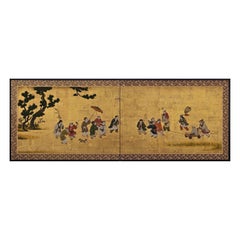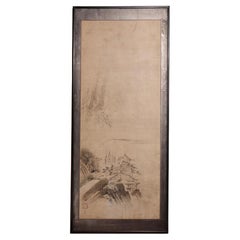17th Century Paintings and Screens
50
to
2
26
5
50
50
50
162
578
903
177
309
222
119
37
4
29
18
14
23
23
22
23
9
40
22
17
16
15
47
44
39
3
3
2
1
1
1
Period: 17th Century
Japanese Screen Painting, Circa 1700 'Tales of Ise' by Tosa Mitsusuke
By Tosa Mitsusuke 1
Located in Kyoto, JP
A six-fold Japanese screen by Tosa Mitsusuke (1675-1710), Japan 17th-18th century, Edo period.
The signature reads Shoroku-i ge Tosa sa Konoe Shogen Mit...
Category
Japanese Edo Antique 17th Century Paintings and Screens
Materials
Gold Leaf
Japanese Six-Panel Screen Garden Landscape by River's Edge
Located in Hudson, NY
Kano School painting showing ancient pine, exotic birds, peonies, azalea and cherry tree in bloom on far right. Early Edo period painting, (1614 -...
Category
Japanese Edo Antique 17th Century Paintings and Screens
Materials
Gold Leaf
Pair of Japanese Edo Rimpa School Screens after Tawaraya Sotatsu
Located in Rio Vista, CA
Impressive pair of 17th century Japanese Edo period Rinpa school screens made in the manner and style of Autumn Grasses by Tawaraya Sotatsu (1570-1640). Beautifully decorated with wi...
Category
Japanese Edo Antique 17th Century Paintings and Screens
Materials
Gold Leaf
17th Century Rinpa School Two-Panel Screen with Koi
By Rimpa School
Located in Fukuoka, JP
17th-18th Century Rinpa School Two-Panel Screen
Period: 17th-18th century
Size: 140 x 125 cm (55 x 49 inches)
SKU: PTA43
This beautiful two-panel screen is a classic example of the...
Category
Japanese Edo Antique 17th Century Paintings and Screens
Materials
Wood, Paper
17th Century Japanese Screen. Karako Asobi: Chinese Children at Play.
Located in Kyoto, JP
Anonymous Kano school artist
17th century
"Karako Asobi: Chinese Children at Play"
A two-panel Japanese Furosaki screen. Ink, pigment, gofun and gold-leaf on paper.
This small Japanese Karako folding screen vividly depicts various games played by children wearing wearing elaborate Chinese T'ang dynasty costumes. They are dressed in plumed and tasseled hats, ornate jackets, baggy pants, and cloth slippers typical of T'ang period Chinese court dress. The children are depicted pulling a younger child along in a cart, carrying another child as if an important official, riding a wooden horse, leading a puppy and carrying a tethered bird. Executed in fine-quality pigments on gold leaf, the detail, variety and size of the figures is noteworthy. Also notable is the size of this screen itself, which denotes it as a Furosaki screen. A Furosaki screen is part of the equipment used for the Japanese tea-ceremony. It is traditionally placed on tatami mats behind the brazier highlighting the utensils and providing a focal point.
Karako is a Japanese term used in art with the depiction of Chinese children playing...
Category
Edo Antique 17th Century Paintings and Screens
Materials
Gold Leaf
Antique Japanese Suibokuga Landscape by Kano Tokinobu, 17th century.
Located in Point Richmond, CA
Antique Japanese Suibokuga Landscape by Kano Tokinobu, 17th century. A sumi-e ink on paper painting illustrating a rocky seaside landscape containing buildings, vegetation and ship masts. The painting with 3 vermillion seals of the artist in the lower left corner. Japanese dry mount paper on a wood frame with thin brocade border silver leafed surround and lacquered wood outer frame.
Condition: Lighter discoloration near the bottom of the painting, various paper restorations, other minor signs of age, wear, stains, otherwise fine condition.
Age: Painting Edo Period, circa 1670. Mounting circa 1985.
Image: 51-1/2 in. x 20-1/2 in. (131cm x 52cm)
Frame: 59-1/4 in. x 25-1/4 in. (150cm x 64cm)
Weight: 6 lbs.
Provenance:
with Honeychurch Antiques...
Category
Japanese Edo Antique 17th Century Paintings and Screens
Materials
Paper
Antique Japanese Suibokuga Egrets by Kano Tokinobu, 17th century.
Located in Point Richmond, CA
Antique Japanese Suibokuga Egrets by Kano Tokinobu, 17th century.
A sumi-e ink on paper painting illustrating two egrets in reserve with no outlines contrasting with the reeds from the marsh in the background. The painting with 3 vermillion seals of the artist in the lower left corner. Japanese dry mount paper on a wood frame with thin brocade border silver leafed surround and lacquered wood outer frame.
Condition: Lighter discoloration on the lower portion of the painting, other minor signs of age, wear, stains and repairs otherwise fine condition.
Age: Painting Edo Period, circa 1670. Mounting circa 1985.
Image: 51-1/2 in. x 20-1/2 in. (131cm x 52cm)
Frame 59-1/4 in. x 25-1/4 in. (150cm x 64cm)
Weight: 6 lbs.
Provenance:
with Honeychurch Antiques...
Category
Japanese Edo Antique 17th Century Paintings and Screens
Materials
Paper
Antique Japanese Suibokuga Sage by Kano Tokinobu, 17th century.
Located in Point Richmond, CA
Antique Japanese Suibokuga Sage Painting by Kano Tokinobu, 17th century. A sumi-e ink on paper painting illustrating an acolyte at a riverbank. The image of the standing Chinese figure with elongated earlobes (a symbol of enlightenment), hair tied back in a kerchief and long beard, holds a large fan in his left hand to his right shoulder. The long robes are windswept with water curls about the figures feet. The painting with 3 vermillion seals of the artist in the lower left corner. Japanese dry mount paper on a wood frame with thin brocade border silver leafed surround and lacquered wood outer frame.
Condition: Paper restoration on center, a quarter of an inch of the left edge of the painting is added, other minor signs of age, wear, stains and repairs overall fine condition.
Age: Painting Edo Period, circa 1670. Mounting circa 1985.
Image: 51-1/2 in. x 20-1/2 in. (131cm x 52cm)
Frame: 59-1/4 in. x 25-1/4 in. (150cm x 64cm)
Weight: 6lbs.
Provenance:
with Honeychurch Antiques...
Category
Japanese Edo Antique 17th Century Paintings and Screens
Materials
Paper
Antique Japanese Suibokuga Landscape by Kano Tokinobu, 17th century.
Located in Point Richmond, CA
Antique Japanese Suibokuga Landscape by Kano Tokinobu. 17th century.
A sumi-e ink on paper painting illustrating an ethereal mountainous landscape at the seashore containing buildings, trees, birds and ship masts. 3 vermillion seals of the artist in the lower right hand corner. Japanese dry mount paper on a wood frame with thin brocade border silver leafed surround and lacquered wood outer frame.
Condition: Minor signs of age, wear, otherwise fine condition.
Age: Painting Edo Period, circa 1670. Mounting circa 1985.
Image: 51-1/2 in. x 20-1/2 in. (131cm x 52cm)
Frame: 59-1/4 in. x 25-1/4 in. (150cm x 64cm)
Weight: 6 lbs.
Provenance:
with Honeychurch Antiques...
Category
Japanese Edo Antique 17th Century Paintings and Screens
Materials
Paper
17th Century Japanese Edo Four Panel Screen Hotei with Chinese Sages
Located in Rio Vista, CA
Beautifully weathered late 17th/early 18th century Japanese edo period four panel byobu screen depicting hotei (fat monk) in a treed landscape with Chinese sages engaged in leisurely...
Category
Japanese Edo Antique 17th Century Paintings and Screens
Materials
Brass
17t century oil painting on canvas
Located in Perth, GB
17t century oil painting on canvas
Category
Antique 17th Century Paintings and Screens
Materials
Canvas
Late 17th Century Japanese Screen. Puppy and Kittens on Gold Leaf.
Located in Kyoto, JP
Anonymous
Late 17th century
Puppy & Kittens
A six-panel Japanese screen. Ink, color, gofun, gold-leaf and gold-fleck on paper.
A medium sized late 17th century Japanese screen fe...
Category
Japanese Edo Antique 17th Century Paintings and Screens
Materials
Gold Leaf
Rare Antique Japanese Folding Screen by Kano Tanshin
By Kano Tanshin
Located in Atlanta, GA
An exquisite Japanese folding screen painted and signed by Kano Tanshin (Morimasa) (1658-1719), circa early Edo Period. An important member of the Kano painter family, the son of Kano Tanyu...
Category
Japanese Japonisme Antique 17th Century Paintings and Screens
Materials
Brass
Japanese Six Panel Screen: Waka Poems on Basketry Design
Located in Hudson, NY
Ribbons of 17th century calligraphy poems are mounted on an 18th century screen with a woven bamboo motif. These poems are aristocratic Waka poem...
Category
Antique 17th Century Paintings and Screens
Materials
Gold, Bronze, Gold Leaf
Japanese Two Panel Screen: Horse Roundup
Located in Hudson, NY
Interesting and unusual subject matter, Tosa School painting in mineral pigments on gold leaf with silk brocade border.
Category
Japanese Antique 17th Century Paintings and Screens
Materials
Gold Leaf
Japanese Two Panel Screen: Hawk Perched in Pine Tree
Located in Hudson, NY
Hawks were a popular motif in artwork because Japanese falconry, or takagari, was a sport of aristocrats such as nobles and samurai. Hawks came to symbolize nobility and strength. Su...
Category
Japanese Antique 17th Century Paintings and Screens
Materials
Brocade, Silk, Paper
Japanese Screen "the Song of Everlasting Sorrow"
Located in PARIS, FR
Six-panels screen depicting the exit from the city of a Chinese emperor on horseback and his concubine in a luxurious palanquin.
It may be a scene illustrating the poem The Song ...
Category
Japanese Antique 17th Century Paintings and Screens
Materials
Wood, Paper, Silk
17th Century Japanese Screen. Ink Plum Tree & Birds by Kano Naonobu.
Located in Kyoto, JP
Kano Naonobu (1607-1650)
Plum Tree and Birds
Six-fold Japanese Screen. Ink and slight color on paper.
In this evocative ink work spread over a six-panel folding screen, we see the consummation of the elegance and refinement of the Edo Kano school. This 17th century screen is a rare surviving example of a large-scale bird and flower painting by Kano Naonobu, the younger brother of Kano Tanyu...
Category
Japanese Edo Antique 17th Century Paintings and Screens
Materials
Wood, Paper
Chinese Ming Dynasty Carved Table Screen
Located in Kastrup, DK
A rare 16-17th cenury Ming Dynasty standing table screen. Untoched original condition.
Hand carved wood, the panel is carved with relief details depicting a dragon, cranes, mythical...
Category
Chinese Ming Antique 17th Century Paintings and Screens
Materials
Wood
17th Century Japanese Screen Pair. Tiger & Dragon by Kaiho Yusetsu
Located in Kyoto, JP
Kaiho Yusetsu (1598-1677)
Tiger and Dragon
Early Edo Period, Circa 1650
A Pair of Six-fold Japanese Screens. Ink and slight color on paper.
Dimensions:
Each screen: H. 171 cm x W. 380 cm (67.5’’ x 149.5’’)
In this pair of early Edo period Japanese screens a group of tigers prowl in a bamboo grove whipped with fierce wind, while a dragon claws through clouds and mist. The dragon embodies elemental qualities - looming out of the mist, the coils of its body disappearing in the clouds. The dragon is calling for rain, symbolizing spring which is considered the fountain of life. On the other side, the tigers calls for the wind, symbolizing autumn which is considered the end of life. Tigers were familiar motifs within Japanese art from ancient times though the animals were imaginary to the people in the 17th century. While dragons and tigers are usually associated as sacred and ferocious, in this painting, both animals have rather amusing expressions. The tigers appear to glare at the dragon with cat-like eyes, and the look on the swirling dragon’s face appears almost affectionate - lending a playful flair to an otherwise magnificent theme.
The tiger and dragon are cosmological symbols of the balancing forces in the world. Screens such as this were originally meant to express the fluctuating nature of the world. For Japanese in the early Edo period, they likely suggested the powers of the cosmos. In Japan the tiger and dragon motif was originally absorbed into the circles of Zen monasteries before spreading into the secular world. The theme especially appealed to the military classes with the Kano school, the official painters to the Shogun and the samurai, being the leading contributors. The painter of this pair of screens, Kaiho Yusetsu (1598-1677), was closely patronized by the third Shogun Tokugawa Iemitsu. In his later years he worked with Kano school artists...
Category
Japanese Edo Antique 17th Century Paintings and Screens
Materials
Silk, Wood, Paper
Pair of Indian Erotic Paintings from a Kama Sutra Series
Located in Dallas, TX
Presenting a stunning piece of Indian antiquity from the 17th century, namely, a pair of indian erotic paintings from a kama sutra series.
India, Orissa, 17th century.
Hand-painted on cloth canvas.
These have impeccable Provenance!
They were purchased by a Private Dallas Collector at Christie’s New York Auction on 19th September 2002. Sale Number 1115, Lot No. 251.
Christie’s operate a twice yearly auction of Southeast Asian Art & Antiquities in New York in the months of March and September.
The Lot was described as: “Two Erotic Paintings from a Karma Sutra...
Category
Indian Archaistic Antique 17th Century Paintings and Screens
Materials
Canvas
17th Century Japanese Screen Pair, Cranes
Located in Kyoto, JP
Cranes
Anonymous, Kano School.
Edo period, second half of the 17th century.
Pair of six-panel screens. Ink, pigment gofun and gold l...
Category
Japanese Edo Antique 17th Century Paintings and Screens
Materials
Gold Leaf
17th Century Japanese Framed Panel by Kano Sansetsu, White Herons in Snow
Located in Kyoto, JP
Kano Sansetsu (1589-1651)
White herons in snow
Edo period, circa 1640
Framed painting. Ink on paper.
Kano Sansetsu is a Japanese painter who ...
Category
Japanese Edo Antique 17th Century Paintings and Screens
Materials
Paper
Important Japanese six-fold screen depicting The Tale of The Genji, 17th century
Located in Amsterdam, NL
An important Japanese six-fold screen, depicting episodes from The Tale of The Genji
Edo period, 17th century
Ink and colour on gilded paper, H. 155 x W. 380 cm
The Tale of Genji...
Category
Japanese Edo Antique 17th Century Paintings and Screens
Materials
Paint, Paper
Japanese Painting, 17th Century, Tale of Genji, Tosa School
Located in Kyoto, JP
Illustration to an unidentified chapter of the Tale of Genji (Genji Monogatari)
Tosa School (second half of the 17th Century)
Ink, pigment, gofun and...
Category
Japanese Edo Antique 17th Century Paintings and Screens
Materials
Gold Leaf
Japanese Screen Painting, circa 1700 'Horses' by Kano Tanshin
Located in Kyoto, JP
Horses
Kano Tanshin Morimasa (1653-1718)
Two-panel tea-ceremony Japanese screen or furosaki
Ink on gold leaf,
late 17th-early 18th century
Measures: H 55 cm x W 182 cm
The Kano school was closely aligned with the warrior class in Japan. The samurai, who lived in a closed and rigid hierarchical society established by the Shogunate, were drawn to the energy and freedom horses symbolize; Kano school artists commonly depicted the equine creatures as they are here, in unfettered and carefree family groups. China originally introduced horse paintings to Japan; the works typically focused on capturing the essence of horses in their various environments and often involved integrating human figures into the images.
Kano Tanshin Morimasa (1653-1718) was the son of Kano Tanyu...
Category
Japanese Edo Antique 17th Century Paintings and Screens
Materials
Gold Leaf
Chinese Early Qing Dynasty "Water and Land Ritual" Painting, 17th Century
Located in Austin, TX
An important Chinese 17th century early Qing Dynasty "Water and Land Ritual" painting, mineral pigment and ink on silk, mounted as a scroll, framed and glazed.
The painting depicting groups of heavenly court officials and deities descending from the clouds to participate in the Liberation Rite of Land and Water. The figures all wear full, sumptuous robes, complete with hats indicating their station. The blue, green, red, black and white of the robes decorated with gilt dragon and geometric designs.
This painting is interesting in that it incorporates Daosit deities and heavenly officials coming down to participate in the Buddhist rite. There are five distinct groups of figures, each with a small inscribed plaque. Some of the groups are identified as Tian Xian, or Heavenly Immortals.
The group at the bottom left are identified as the Sanguan Dadi, or Three Great Emperor-Officials. The Emperor of Heaven is dressed in blue robes with gilt painted dragons. The Emperor of Water wears black robes. The Emperor of Earth wears yellow robes...
Category
Chinese Qing Antique 17th Century Paintings and Screens
Materials
Silk, Glass, Giltwood, Paint
Circa 1700 Japanese Screen Pair, Cranes & Pines, Kyoto Kano School
Located in Kyoto, JP
Pines and Cranes
Anonymous. Kyoto Kano School.
Late 17th/early 18th centuries, circa 1700.
Pair of six-panel Japanese folding screens.
Ink, gofun, pigment and gold leaf on paper.
This bold composition presents two pine trees extending to the left and right across a gold leaf background. One tree is silhouetted against a green ground, golden clouds obscuring its true size, the other stretches across a stylized waterway. The pines are paired with Manchurian cranes with red crests and snow white plumage. Both have been highly auspicious motifs in East Asia since Chinese antiquity. Here the artist utilized fluid and instinctive ink brushstrokes to define the trunk, branches and tail feathers, in strong contrast to the precision and sharp angularity of the crane’s legs and beaks. The adoption of this vast metallic painting support required an unerring sense of design and composition, so that the negative space surrounding motifs could imply context for the otherwise floating pictorial elements. The brushwork detailing the trunks of the pines, the exaggerated dimensions of the pine trees and the strength and dynamism of the composition are all reminiscent of Kano Eitoku...
Category
Japanese Edo Antique 17th Century Paintings and Screens
Materials
Gold Leaf
17th Century Japanese Screen Pair by Soga Nichokuan, Hawks on Pine & Plum Trees
Located in Kyoto, JP
Hawks on plum and pine
Soga Nichokuan (active circa 1625-1660)
Pair of six-fold screens.
Ink, mineral pigments, gofun, gold and speckled gold leaf on paper.
Upper seal: H...
Category
Japanese Edo Antique 17th Century Paintings and Screens
Materials
Wood, Paper
17th Century Korean Grapevine and Squirrel Scroll Painting, Mid Joseon Period
Located in Kyoto, JP
Anonymous. Korean, 17th century. Joseon period.
Hanging scroll. Ink on paper.
Seal: Shinso
Dimensions:
Scroll: H. 200 cm x W. 31 cm (79” x 12”)
Image: H. 122 cm x W. 29.5 cm (48” x 11.5”)
The grapevine came to China and then Korea from western Asia via the silk road trade routes. By the mid-Joseon period, it was one of the most popular subjects for Korean literati painters. Grapevines were painted as a singular subject or, less commonly, in combination with squirrels, which are associated with children due to their playful nature. Together, grapevines and squirrels embody wishes for abundant offspring and wealth.
For the Korean literati artist the twisting vines, curling tendrils and round, plump grapes provided ample opportunity for expressive "brush play”. In this painting the artist has abstracted the scene and is seemingly unconcerned with discontinuities and proportion. Vines spring up from nowhere, grapes hang in random clusters and the squirrel’s head appears as if twisted backwards. For the vines and leaves we can feel a sense of speed in the brushstrokes, imparting a dynamic feel which is at once intense and animated. This contrasts dramatically with the countless tiny strokes of ink which realistically capture the texture of the squirrel’s fur...
Category
Korean Other Antique 17th Century Paintings and Screens
Materials
Paper
Ming Dynasty Chinese Mural Painting of Buddha Flanked by Attendants
Located in Chicago, IL
This rare mural was painted in China over four centuries ago, and is an exquisite example of Buddhist art. The enlightened Buddha is shown standing at the center of the painting, dre...
Category
Chinese Ming Antique 17th Century Paintings and Screens
Materials
Wood
17th Century Japanese Framed Painting by Kano Sansetsu, Plum Blossoms in Snow
Located in Kyoto, JP
Kano Sansetsu (1589-1651)
Plum blossoms in snow
Edo period, circa 1640
Framed painting. Ink on paper.
Kano Sansetsu is a Japanese painter who...
Category
Japanese Edo Antique 17th Century Paintings and Screens
Materials
Paper
Pair of Japanese Ink Hanging Scrolls Kano Tanyu
By Kano Tan'yu 1
Located in Atlanta, GA
A fine matching pair of hanging scrolls ink on paper mounted in green brocade borders circa Edo period (17-18th century). The Kano school painting depicts wild geese in the reeds by the margin of water, a popular subject borrowed from the Chinese tradition. Both painting were signed as Tanyu with a red seal of Morinobu, his birth name. The storage box is also present and was inscribed with the title Painting of Geese and Reeds and Kano Tanyu...
Category
Japanese Japonisme Antique 17th Century Paintings and Screens
Materials
Wood, Paper
17th Century Japanese Two-Panel Screen, Gibbons of Folklore
Located in Hudson, NY
Japanese two-panel screen: Gibbons of Folklore, Edo period (17th century) Kano School painting of gibbons in Japanese fables. The left panel represents a Japanese fable of a monkey a...
Category
Japanese Edo Antique 17th Century Paintings and Screens
Materials
Silk, Wood, Paper
Lovely 17th-18th Century Scroll Painting Japan Artist Kano Soyu Painted
Located in Amsterdam, Noord Holland
It is a work that is said to have been drawn by Kano Soyu as you can see.
It is a picture of the light-colored Sansui map carefully drawn to the smallest detail, and the
towering m...
Category
Japanese Edo Antique 17th Century Paintings and Screens
Materials
Silk
Japanese Edo Painted Screen with Imperial Court Scenes
Located in New York, NY
Japanese Edo period two-panel screen with a pair of finely painted imperial court scenes representing court ladies as poets and musicians. The paintings are 17th century Edo period...
Category
Japanese Edo Antique 17th Century Paintings and Screens
Materials
Lacquer
Late 17th-Early 18th Century Japanese Six-Panel Screen, Battle at Uji Bridge
Located in Hudson, NY
Japanese six-panel screen: Battle at Uji Bridge, the first battle at Uji was in 1180 and it marked the start of the Heike Wars. The Genji troops crossed the...
Category
Japanese Edo Antique 17th Century Paintings and Screens
Materials
Gold Leaf
Japanese 17th Century Two Panel Screen, Pine with Gold Dust
Located in Hudson, NY
Beautiful 17th century painting of pine trees. Painting in good condition on 19th century mounting. Mineral pigments and gold dust on mulberry paper w...
Category
Japanese Edo Antique 17th Century Paintings and Screens
Materials
Paper
Korean Painting, Wall Panel, 17th Century Ink Grapevine
Located in Kyoto, JP
Grapevine
Anonymous. Korean, 17th century.
Wall panel, ink on paper.
Upper seal:
Kou Kinun in
Lower seal:
Kaigen
Dimensions:
Measures: 98.5 cm x 29.5 cm (39” ...
Category
Korean Other Antique 17th Century Paintings and Screens
Materials
Wood, Paper
Japanese Painting, 17th Century, Tale of Genji, Makibashira, Tosa School
Located in Kyoto, JP
The Handsome Pillar (Makibashira), Illustration to Chapter 31 of the Tale of Genji (Genji Monogatari)
Tosa School (second half of the 17th Century)
I...
Category
Japanese Edo Antique 17th Century Paintings and Screens
Materials
Gold Leaf
Japanese Four-Panel Screen, Horses in Stable Setting
Located in Hudson, NY
Japanese Four Panel Screen: Horses in Stable Setting, Edo period painting (17th century) of a very popular samurai subject matter. Samurai were highly...
Category
Japanese Antique 17th Century Paintings and Screens
Materials
Silk, Wood, Paper
Japanese Painting, 17th Century, Tale of Genji, Fujibakama, Tosa School
Located in Kyoto, JP
Purple Trousers (Fujibakama), Illustration to Chapter 30 of the Tale of Genji (Genji Monogatari)
Tosa School (second half of the 17th century)
Ink, ...
Category
Japanese Edo Antique 17th Century Paintings and Screens
Materials
Gold Leaf
Antique Japanese Hanging Scroll Attributed to Iwasa Matabei
Located in Atlanta, GA
An antique ink and color on paper hanging scroll (kakejiku) with brocade border. It appears to be a fragment of a larger hand scroll depicting a procession of a lord with his entoura...
Category
Japanese Japonisme Antique 17th Century Paintings and Screens
Materials
Silk, Paper
17C SE Asian Indian Set of 8 Paintings from a Yantra
Located in Dallas, TX
Presenting a stunning piece of Indian Antiquity from the 17th century, namely, a 17th century set of 8 paintings from a Yantra.
Hastakara Yantra …. from Western India.
This piece has impeccable Provenance !
It was purchased by a Private Dallas Collector at Christie’s New York Auction on 21st March 2007. Sale Number 1812, Lot No. 393.
Christie’s operate a twice yearly auction of Southeast Asian Art & Antiquities in New York in the months of March and September.
The Lot was described as: “Property of the Estate of Blanche Manso.
Eight paintings from a yantra.
Western India, 17th century.
Each side drawn with a chariot shape divided into blocks of text, numbered and labeled in the margins, decorated with bright pink, yellow and green on handmade paper.
4.25 x 8.25 in (10.8 x 20.9 cm.) each (8).
Provenance: From the Collection of Blanche Manso”
It carried an Auction estimate of USD 1,000 to USD 1,500 and sold for USD 960 (not including buyers premium...
Category
Indian Archaistic Antique 17th Century Paintings and Screens
Materials
Paper
17th century Japanese Falcon Painting, Mitani Toshuku, Unkoku School
Located in Kyoto, JP
Mitani Toshuku (1577-1654)
“Falcon”
Wall panel, ink and light color on paper.
Upper Seal: Mitani
Lower Seal: Toshuku
Dimensions:
Each 118.5 cm x 51 cm x 2 cm (46.5” x 20” x .75”)
Individual falcon paintings by Mitani Toshuku (1577-1654), an early artist of the Unkoku School. Founded by Unkoku Togan (1547–1618), a master of the Momoyama period, the Unkoku school enjoyed long lasting patronage in southern Japan. Togan was a retainer of the Mori family in present day Yamaguchi prefecture. Members of the school considered themselves to be in the artistic lineage of Sesshu Toyo...
Category
Japanese Edo Antique 17th Century Paintings and Screens
Materials
Paper
Japanese Painting, Framed Panel, 17th Century Falcon by Mitani Toshuku
Located in Kyoto, JP
Mitani Toshuku (1577-1654)
“Falcon”
Wall panel, ink and light color on paper.
Upper seal: Mitani
Lower seal: Toshuku
Dimensions:
Each 118.5 cm x 51 cm x 2 cm (46.5” x 20” x .75”)
Individual falcon paintings by Mitani Toshuku (1577-1654), an early artist of the Unkoku School. Founded by Unkoku Togan (1547–1618), a master of the Momoyama period, the Unkoku school enjoyed long lasting patronage in southern Japan. Togan was a retainer of the Mori family in present day Yamaguchi prefecture. Members of the school considered themselves to be in the artistic lineage of Sesshu Toyo...
Category
Japanese Edo Antique 17th Century Paintings and Screens
Materials
Wood, Paper
Japanese Two Panel Screen: Romping Cats Under Sago Palms
Located in Hudson, NY
Japanese Two Panel Screen: Romping Cats Under Sago Palms
Beautifully painted mineral pigments on mulberry paper
Category
Japanese Antique 17th Century Paintings and Screens
Materials
Brocade, Paper
17th Century Folio of Indian Persian Mughal School Miniature Painting.
Located in Vero Beach, FL
17th Century Folio of Indian Persian Mughal School Miniature Painting.
Exceptional and lavishly illustrated Indo Persian Mughal miniature. Bathing females try to cover themselves before the arrival of a prince in a carriage. This is a snapshot of Indian royal court life. In the 16th and 17th century semi-nude women in art came to replace the heroes of Persian epics. These early Mughal portraits...
Category
Indian Other Antique 17th Century Paintings and Screens
Materials
Paper
Japanese Six Panel Screen, Morning Glories on a Bamboo Arbor
Located in Hudson, NY
Very early painting of a gold arbor with morning glories, the mulberry paper almost appears polished. Please see close-up photos to show staining from use over the many years (on the...
Category
Japanese Antique 17th Century Paintings and Screens
Materials
Paper
Japanese Two-Panel Screen, Battle Scene from Heike Wars
Located in Hudson, NY
Tosa School painting depicting opposing samurai, Benkei and Yoshitsune, excellent detail, mineral pigments on gold leaf with gold dust.
Category
Japanese Antique 17th Century Paintings and Screens
Materials
Gold Leaf
Recently Viewed
View AllMore Ways To Browse
Antique Japanese Paintings On Silk
Japanese Panel Folding
Antique Japanese Painting On Silk
Japanese Edo Screens
Chinese Screen Two
Edo Panel
Japanese Pictures
Hand Painted Antique Screen
Vintage Asian Painting
Japanese Meiji Screen
Chinese Panel Lacquered Screen
Antique Screen Doors
Antique Door Screen
Chinese 4 Panel
Carved Window Panels
4 Panel Chinese
Asian Lattice
Black Lacquer Asian Painting
